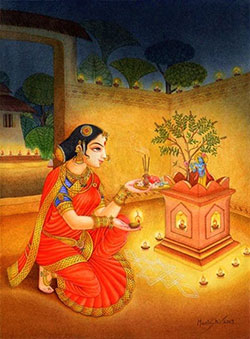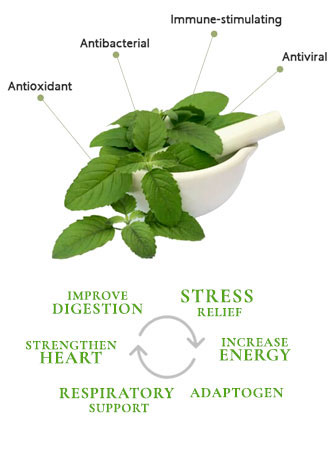Tulsi, also known as Holi Basil, is a sacred plant revered for its medicinal properties for thousands of years in the ancient Indian system of medicine. Did you know that ancient texts of Ayurveda, Siddha, Greek, and Roman medicine describe tulsi as the elixir of life and longevity and an herb with holistic healing powers?

Legends of Tulsi
Vrinda was a devoted wife of the demon king Jalandhar, whose loyalty made him invincible. To defeat Jalandhar, Lord Vishnu disguised himself as him and broke Vrinda’s trust. In grief and anger, she cursed Vishnu. Moved by her devotion, Vishnu transformed her into the Tulsi plant, ensuring her essence remained with him.
In Western cultures, tulsi is considered one of Christ’s gifts. According to legend, the value of a single tulsi leaf offered with devotion is immeasurable, far outweighing the value of any amount of gold or wealth.
Thus, Tulsi symbolizes purity and devotion, believing that having Tulsi plants in the home brings prosperity and divine blessings.
Regardless of its spiritual powers and legends, this herb undoubtedly has tremendous health benefits.
Origin of the name
Tulsi is an herb whose name derives from the Sanskrit word “Tulsa,” which translates to “incomparable.” Its Latin name is “Ocimum sanctum,” which means holy basil or holy king. This herb is considered the king/queen of all herbs because of its unique and specific immense healing properties.
Types of tulsi
Tulsi, or holy basil (Ocimum sanctum), is a member of the mint family, Lamiaceae. There are many (around 60) types of tulsi in the world, although there are three most commonly used for medical treatment:
- Rama Tulsi (Ocimum sanctum), Light Holy Basil
This type of tulsi has green leaves and white flowers. It has a cooling, mellow taste and a clove-like scent. It heals fevers and coughs and is considered a liver tonic. - Krishna Tulsi or Shyama (Ocimum tenuiflorum), Dark Holy Basil
This type of tulsi has dark purple leaves that are smaller than the Rama tulsi. It has a strong aroma and a spicy flavour. It treats bronchitis, malaria, asthma, genitourinary disorders, diabetes, and heart problems. - Vana Tulsi (Ocimum gratissimum), Wild Leaf Holy Basil
This type of tulsi is very similar to Rama tulsi but has a more intense aroma (due to more eugenol) and is taller than other forms. It treats malaria, tuberculosis, diabetes, asthma, and other conditions.

How does it work
According to Ayurveda, tulsi is a Rasayana or plant that can fundamentally rejuvenate, restore balance and harmony in the mind, body, and spirit, and provide long life due to its immense effect on the body, mind, and spirit pillar of herbal medicine due to its vast effect improving metabolism and digestion, nurturing the skin, reproductive and nervous systems, lowering fever, and killing harmful bacteria and microbes.
In Western herbalism, tulsi is a perfect adaptogen – it helps the body and mind cope with stress (physical and emotional). With hundreds of beneficial compounds, tulsi also has many antioxidants and robust components that reduce the number of free radicals in the body (reactive molecules that steal electrons from the body).
Examples of how tulsi works:
- Reduces stress and anxiety
- The synergy of the components found in tulsi makes it a powerful adaptogen, enhancer, and builder of the immune system. It helps the body fight stress, maintain good health, strengthen the digestive system and metabolism, improve vitality, and stimulate energy.
- Research has shown that taking tulsi tea decreases the level of stress hormones, especially corticosterone.
- Stimulates and vitalizes your body
- Tulsi contains antioxidants that protect the body from toxins, prevent cancer formation, and reduce cancer cell growth.
- Protects against infections and acne and treats wounds
- The tulsi leaf is most commonly used as an antibiotic, germicidal and disinfectant agent since one of the main compounds of tulsi is eugenol and gamma-caryophyllene oil. Therefore, it protects us from bacteria and viruses.
- Using tulsi extract can speed up healing wounds and scars post-surgery.
- Lowers your blood sugar
- Because of its powerful capacity to balance and enhance metabolic reactions, tulsi is highly effective in fighting diabetes.
- Experiments on rats that received a tulsi extract for 30 days found that their blood sugar level was reduced by 24%.
- Lowers your cholesterol
- Tulsi reduces metabolic stress, helping reduce body weight and cholesterol levels. Research conducted on rabbits who ate fresh tulsi leaves for 30 days found significant differences in the molecular structure of their fatty acids.
- It has been shown that eugenol, one of the oils in tulsi, reduces LDL-cholesterol (“bad” cholesterol) and increases the level of HDL-cholesterol (good cholesterol) and thus also affects the health of the heart and bloodstream.
- Protects your stomach
- Tulsi removes stress-induced ulcers and naturally increases stomach circulation, reduces acidity, strengthens stomach mucus, and increases the life span of mucus cells.
- Helps Improve Respiratory Disorders
- Components found in tulsi, such as camphene, eugenol, and cineole, help eliminate breathing difficulties and other respiratory problems.
Tulsi can purify water from bacteria, fungi and fluoride

Researchers from Rajasthan University in India have discovered that tulsi can remove a certain amount of fluoride from the water. An experiment was carried out in the Yellareddyguda village in Narketpally Mandal, where the researchers soaked 75 mg tulsi in 100 ml of water containing 7.4 ppm of fluoride. After only eight hours of soaking leaves in the water, the fluoride level was reduced to just 1.1 ppm.
A high percentage of fluoride in the water causes many health problems. Some known side effects of drinking water with too much fluoride are depleting brain capacity, causing ADD and ADHD, calcifying the pineal gland, reducing IQ in children and nerve damage.
However, more research is still needed to identify and validate the effectiveness of using tulsi leaves to remove fluoride from drinking water supplies. You can also use tulsi in drinking water for other purposes, like eliminating bacteria and fungus.
Possible side effects
Tulsi is a plant that is safe for consumption. However, it is necessary not to consume it in large quantities to avoid unpleasant detox symptoms such as headaches, rapid heartbeat, weakness, or nausea.
Since one of the effects of tulsi is its property to dilute the blood, those who use antiplatelet drugs such as aspirin, clopidogrel, dalteparin, enoxaparin and others must be cautious when using tulsi. We advise you to consult your doctor before using tulsi (especially extract) if you consume these medicines.
Since tulsi dilutes the blood, you should not use it at least two weeks before surgery. Also, during pregnancy and breastfeeding, we advise you not to use tulsi.

How to use Tulsi
Tulsi can be used raw as a spice, tea, essential oil, or extract. Different forms of the tulsi plant can be used orally.
NOTE! Essential oil is usually used for external use only (due to its high concentration)—for skin disorders, acne, hair loss, and inhalation during cough, cold, or other respiratory problems.
To strengthen your immune system and balance all systems, chew a few fresh leaves and prepare tulsi tea. Whatever form you use, just be careful about the product quality (especially with extracts) and ensure it is from a reliable source and manufacturer.
If you have any additional questions, kindly write or leave a comment below.
By Kristina Babic


